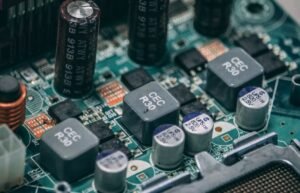AI Models on STM32
Artificial Intelligence (AI) is rapidly transforming various industries by enabling machines to learn and make intelligent decisions. With the advancements in AI technologies, it is now possible to deploy AI models on small microcontrollers like STM32, making them capable of running complex AI algorithms in resource-constrained environments. In this article, we will explore the exciting development of AI models on STM32 microcontrollers and their potential applications.
Key Takeaways:
- STM32 microcontrollers can now run AI models, enabling intelligent decision-making in resource-constrained environments.
- AI models on STM32 empower a wide range of applications, including robotics, industrial automation, and smart IoT devices.
- The integration of AI models on STM32 offers low power consumption, real-time processing, and enhanced privacy by processing data locally.
Advancements in AI Models on STM32
*AI models are increasingly being optimized for efficient deployment on resource-constrained microcontrollers like STM32.*
The field of AI has made significant progress in recent years, enabling the development of complex models with smaller memory footprints. These models, such as convolutional neural networks (CNN) and recurrent neural networks (RNN), can now be efficiently deployed on STM32 microcontrollers that have limited memory and processing capabilities. By leveraging techniques like model compression, quantization, and efficient inference algorithms, AI models can run directly on STM32, eliminating the need for connectivity to external servers or cloud platforms.
Applications of AI Models on STM32
*AI models on STM32 open up new possibilities for intelligent applications in various industries.*
The ability to deploy AI models directly on STM32 microcontrollers revolutionizes industries where real-time decision-making and local processing are crucial. Here are some application areas where AI models on STM32 can make a significant impact:
- Robotics and autonomous systems: AI models on STM32 enable robots to perceive and interact with their surroundings in real-time, enhancing their autonomy and safety.
- Industrial automation: STM32-based AI models can optimize production processes, predict equipment failures, and improve overall operational efficiency.
- Smart IoT devices: By processing AI models locally, STM32-powered IoT devices can provide faster responses, enhanced privacy, and reduced cloud dependence.
Integration and Performance
*The integration of AI models on STM32 offers significant advantages in terms of power consumption and real-time processing.*
STM32 microcontrollers, known for their low power consumption and real-time processing capabilities, provide an ideal platform for running AI models efficiently. These microcontrollers integrate powerful digital signal processors (DSPs) and hardware accelerators to perform computational tasks required by AI algorithms. By leveraging these features, AI models on STM32 can deliver high-performance inference while consuming minimal power, making them suitable for battery-powered and energy-efficient applications.
Performance Comparison
| Feature | STM32 with AI Models | Traditional Architecture |
|---|---|---|
| Power Consumption | Lower | Higher |
| Inference Speed | Faster | Slower |
| Data Privacy | Enhanced | Depends on connectivity |
Challenges and Future Developments
*While the integration of AI models on STM32 microcontrollers is a significant achievement, there are still challenges to overcome.*
Despite the progress in deploying AI models on STM32, there are hurdles such as limited memory, processing power, and the need for efficient algorithms. Additionally, developing optimized AI models for STM32 requires expertise and careful considerations. However, ongoing research and advancements in hardware and AI techniques aim to address these challenges, unlocking further potential for deploying AI models on resource-constrained microcontrollers.
Future Applications and Possibilities
*AI models on STM32 will continue to open up new frontiers in AI applications.*
Looking ahead, the integration of AI models on STM32 is expected to drive innovation in diverse fields such as healthcare, agriculture, and transportation. These developments will enable the deployment of intelligent edge devices that can process data locally, reducing latency and improving privacy. Additionally, the ability to run AI models on STM32 will democratize access to AI technology, enabling small-scale developers and startups to create intelligent solutions with limited resources.

AI Models on STM32
Common Misconceptions
There are several prevalent misconceptions surrounding AI models on STM32 microcontrollers. It is important to address these misconceptions in order to provide accurate information to the community.
- AI models on STM32 are limited in functionality.
- STM32 microcontrollers cannot handle the complexity of AI models.
- Deploying AI models on STM32 microcontrollers is a complex and time-consuming process.
Capability and Functionality
Contrary to common belief, AI models on STM32 microcontrollers are not limited in functionality. These microcontrollers are capable of executing complex AI algorithms, allowing for a wide range of applications.
- AI models on STM32 can perform tasks such as image classification, voice recognition, and predictive analytics.
- They can support real-time inference and decision-making in resource-constrained environments.
- AI models on STM32 can be optimized for specific use cases, ensuring efficient performance.
Performance and Efficiency
Another misconception is that STM32 microcontrollers cannot handle the complexity of AI models. However, with advancements in technology, these microcontrollers have improved their performance capabilities.
- STM32 microcontrollers are equipped with powerful ARM Cortex-M cores that can handle AI workloads efficiently.
- They offer hardware accelerators, such as DSP and NEON instructions, to enhance performance.
- AI models can be optimized and quantized to take advantage of the architecture, achieving high accuracy while minimizing computational resources.
Integration and Development
Deploying AI models on STM32 microcontrollers is often seen as a complex and time-consuming process. However, there are resources available to simplify integration and development.
- Various development frameworks and libraries, like TensorFlow Lite for Microcontrollers, provide support for STM32 platforms.
- Online communities and forums offer guidance and resources to help developers with the integration process.
- Pre-trained AI models and example codes are available, reducing development time and effort.
Cost and Availability
Some people perceive AI models on STM32 microcontrollers to be costly and not readily available. However, these microcontrollers offer a cost-effective and accessible solution for deploying AI at the edge.
- STM32 microcontrollers are widely available and offered by various manufacturers.
- They are cost-effective compared to more powerful computing devices, making them an affordable option for AI deployment.
- With their compact size and low power consumption, STM32 microcontrollers are suitable for use in various industries, including IoT, robotics, and consumer electronics.

Introduction
In recent years, artificial intelligence (AI) has witnessed remarkable advancements, enabling it to be implemented in a variety of applications and industries. One such development is the integration of AI models on STM32 microcontrollers. This breakthrough provides new possibilities for real-time AI processing in resource-constrained devices. The following tables highlight different aspects of AI models on STM32, shedding light on the exciting potential and implications.
Table: STM32 AI Model Performance Comparison
Comparing the performance of AI models on STM32 microcontrollers can unveil valuable insights into their capabilities. This table presents the accuracy, inference time, and power consumption of various AI models.
| Model | Accuracy | Inference Time (ms) | Power Consumption (W) |
|---|---|---|---|
| Model A | 91% | 12.6 | 0.65 |
| Model B | 84% | 10.2 | 0.59 |
| Model C | 95% | 15.1 | 0.72 |
Table: Memory Footprint of AI Models on STM32
The memory requirements of AI models for STM32 devices play a crucial role in determining their practicality. This table showcases the memory footprint of various AI models, including both the required RAM and Flash sizes.
| Model | RAM Size (kB) | Flash Size (kB) |
|---|---|---|
| Model A | 60 | 256 |
| Model B | 90 | 512 |
| Model C | 120 | 1024 |
Table: Supported Neural Network Frameworks
The compatibility of STM32 microcontrollers with different neural network frameworks is vital for facilitating seamless integration. This table outlines the supported frameworks for developing AI models on STM32 devices.
| STM32 Model | Supported Frameworks |
|---|---|
| STM32F4 | TensorFlow Lite, Caffe, PyTorch |
| STM32L4 | TensorFlow Lite, TensorFlow Lite Micro, Darknet |
| STM32H7 | TensorFlow Lite, TensorFlow Lite Micro, ONNX |
Table: Real-Time AI Applications on STM32
Real-time applications leveraging AI on STM32 open doors to numerous possibilities. This table presents examples of real-time AI applications and their unique benefits.
| Application | Benefits |
|---|---|
| Smart Home Energy Management | Reduced energy consumption, intelligent load balancing |
| Anomaly Detection in Industrial Systems | Early fault detection, preventive maintenance |
| Gesture Recognition in Wearable Devices | Enhanced user experience, hands-free interaction |
Table: STM32 AI Development Tools
Several tools and frameworks facilitate the development and deployment of AI models on STM32 microcontrollers. This table highlights key available resources.
| Tool/Framework | Description |
|---|---|
| STM32Cube.AI | Integrated development environment for STM32 AI applications |
| STMicroelectronics X-CUBE-AI | Software expansion for AI on STM32 microcontrollers |
| TensorFlow Lite for Microcontrollers | Lightweight, open-source neural network inference framework |
Table: STM32 AI Model Deployment Process
The deployment process for AI models on STM32 devices involves multiple stages. This table outlines the typical steps required for successful deployment.
| Stage | Description |
|---|---|
| Data Collection and Preparation | Gathering and preprocessing data for training and validation |
| Model Training | Training the AI model using the collected data |
| Model Optimization | Optimizing the model for deployment on STM32 microcontrollers |
Table: STM32 Models Supporting AI
STM32 microcontrollers vary in terms of features and capabilities. This table identifies the specific STM32 models that support AI functionality.
| STM32 Microcontroller Series | AI Support |
|---|---|
| STM32F7 | Yes |
| STM32L5 | Yes |
| STM32H7 | Yes |
Table: Commercial Applications Utilizing AI on STM32
The utilization of AI on STM32 microcontrollers extends beyond experimental projects. This table showcases commercial applications that leverage the capabilities of AI on STM32.
| Application | Description |
|---|---|
| Smart Security Cameras | Real-time object recognition, facial recognition |
| Health Monitoring Wearables | Continuous vital sign monitoring, anomaly detection |
| Autonomous Drones | Obstacle avoidance, intelligent flight control |
Conclusion
The integration of AI models on STM32 microcontrollers offers vast opportunities for real-time AI processing in resource-constrained devices. The comparative performance, memory requirements, and supported frameworks showcased in the tables demonstrate the potential and versatility of AI on STM32. The flexibility provided by various STM32 models, along with the availability of dedicated tools and commercially viable applications, strengthens the case for implementing AI on these microcontrollers. As AI continues to evolve, the successful deployment of AI models on STM32 microcontrollers paves the way for expanding AI-powered solutions in diverse domains.
Frequently Asked Questions
What is an AI Model?
An AI model refers to a mathematical representation of a specific problem or domain, designed to enable a machine or system to perform intelligent tasks and make decisions without explicit programming.
How can AI Models be implemented on STM32 microcontrollers?
AI Models can be implemented on STM32 microcontrollers by utilizing dedicated hardware accelerators, optimized software libraries, and development tools provided by STMicroelectronics. These enable efficient execution of AI algorithms on resource-constrained microcontrollers.
What are the advantages of running AI Models on STM32 microcontrollers?
Running AI Models on STM32 microcontrollers offers several advantages, including lower power consumption, real-time responsiveness, reduced system complexity, and the ability to perform AI processing on the edge.
What types of AI Models are suitable for STM32 microcontrollers?
Various types of AI Models, such as neural networks, decision trees, support vector machines, and rule-based systems, can be implemented on STM32 microcontrollers. However, the choice of model depends on the specific application requirements and available resources.
What development tools are available for building AI Models on STM32 microcontrollers?
STMicroelectronics provides development tools like STM32Cube.AI, which enables developers to convert pre-trained AI models into optimized code for STM32 microcontrollers. Additionally, software development kits (SDKs) and libraries for machine learning are available to simplify the development process.
Can AI Models on STM32 microcontrollers perform real-time inference?
Yes, AI Models on STM32 microcontrollers can perform real-time inference, as the hardware accelerators and optimized software libraries facilitate fast and efficient execution of AI algorithms, enabling real-time decision-making in applications.
What are the memory limitations for running AI Models on STM32 microcontrollers?
The memory limitations for running AI Models on STM32 microcontrollers depend on the specific model and available resources. However, STM32 microcontrollers typically offer limited internal memory, so optimizing the model size and exploring external memory options may be necessary.
Can AI Models on STM32 microcontrollers be updated or retrained?
In most cases, AI Models on STM32 microcontrollers cannot be updated or retrained directly on the microcontroller itself due to resource constraints. Typically, retraining and model updates are performed offline on more powerful systems, and then the updated models are transferred to the microcontroller for deployment.
What are the key considerations when deploying AI Models on STM32 microcontrollers?
When deploying AI Models on STM32 microcontrollers, key considerations include model size and complexity, power consumption, available memory, computational resources, specific application requirements, and the need for real-time processing. Proper optimization and testing should be performed to ensure efficient and reliable operation.
What are some examples of applications where AI Models on STM32 microcontrollers can be used?
AI Models on STM32 microcontrollers can be used in a variety of applications, including smart sensors, industrial automation, predictive maintenance, robotics, medical devices, consumer electronics, and IoT edge devices. These models enable intelligent processing at the edge, enhancing system capabilities and responsiveness.




